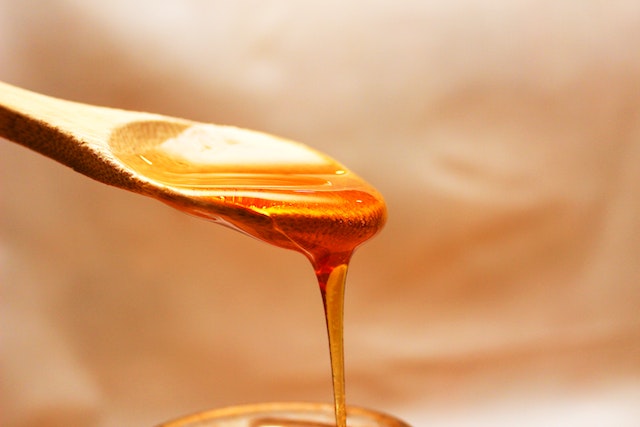
What makes things sticky? When the molecules in two substances are attracted to each other things become sticky. The stickiness of an adhesive and the stickiness of something like maple syrup are a little bit different from each other. Let’s look at the stickiness of glue, adhesive tape, and maple syrup.
There are many different types of glue, so let’s focus on wood glue. The first glues were made from boiling down the bark of a birch tree. People then shifted to boiling down animal hides, hooves, and connective tissue. These days, most glues are synthetic, although some do still contain animal collagen. The most common wood and craft glue is the white glue, which contains polyvinyl acetate.
PVA glue is sticky because it gets into the pores in wood or paper and then expands when it dries. PVA is an aliphatic rubbery synthetic polymer. “Aliphatic” means it can be saturated with another substance, in this case, water, and it is a polymer because it contains long chains of carbon molecules. PVA glue is a liquid and when you apply it to wood or paper, it goes into the pores in the material. Once there, the hydrogen molecules in the glue get attracted to the hydrogen molecules in the wood or the paper and they stick to each other. After the glue dries, these hydrogen bonds become a permanent connection, holding the wood together.
Adhesive tape works on a different principle. The original idea behind adhesive tape was to make a material that would stick to something, but that could also be removed as well. Richard Drew, the inventor of masking tape, watched people painting cars. They used glue and paper to mask the areas they didn’t want to get paint on, but the glue would stick so well that when they tried to peel the paper off, it would take the paint with it. Richard Drew decided to come up with a material that could stick and peel off without ruining the paint. He came up with masking tape in 1925.
Wood glue sticks because of a chemical reaction. Masking tape sticks because of a physical reaction. The adhesive on masking tape and other tapes is made of rubber, silicone, or acrylic. Rubber seems to be the most common because they are the most adhesive. However, acrylic tape works better at lower temperatures and silicone works better at higher temperatures.
The adhesive on tape works because it is a viscous, liquid-like material and not a solid. When the tape is applied to something, it is pressed down. This pressure causes the adhesive to spread out and enter the cracks and pores in the object. Even when we think something is completely smooth, it still has pores in it. This process is called wetting and the more pores the adhesive can go into, the stronger it will stick. Once the adhesive has spread out, something called Van der Waals forces increase the attraction. This is what geckos use when they climb a wall. Van der Waals forces are weak intermolecular forces that are dependent on the distance between molecules. When the masking tape is pressed and the adhesive spreads out, there are more molecules in the tape that come into contact and are attracted to more molecules on the surface. This creates a greater attraction. However, when you pull the tape back up, you apply more force to the tape than the Van der Waals forces can give and the tape is easy to pull up again.
Maple syrup’s stickiness comes from the sugar dissolved in it. Dry sugar is not sticky, but when you dissolve it in water, the molecules spread out and the oxygen atoms on the outside of the sugar molecules with a negative charge are attracted to the positive charge of the hydrogen molecules in the water. This makes maple syrup viscous and sticky. The attraction between the hydrogen atoms and the sugar molecules is not very strong and it can be overcome, but it is enough to make syrup stick to anything. It also makes the syrup viscous, so it sinks into pores and cracks. This is the reason why syrup and icing stick to our fingers as well. We have molecules with a positive charge in our skin and that attracts the oxygen in the liquid sugar. We also have wrinkles and pores that the syrup can get into, increasing the amount of molecules it can come in contact with. We can overcome the attraction by wiping our hands, but it is enough to cause stickiness. And this is what I learned today.
Photo by Three-shots: https://www.pexels.com/photo/close-up-photography-of-honey-714522/
Sources
https://www.sciencedirect.com/topics/chemistry/poly-vinyl-acetate
https://en.wikipedia.org/wiki/Wood_glue
https://perspectivesinmedicine.cshlp.org/content/4/12/a015255
https://en.wikipedia.org/wiki/Masking_tape
https://www.acs.org/education/outreach/celebrating-chemistry-editions/2020-ncw.html
https://byjus.com/chemistry/van-der-waals-forces/
https://www.thenakedscientists.com/articles/questions/what-makes-things-sticky
https://www.permabond.com/resource-center/in-english-doc-how-do-adhesives-work/
https://www.scientificamerican.com/article/what-exactly-is-the-physi/
https://ipgblog.blogspot.com/2017/01/masking-tape-core-basics-written-by.html
https://mpi-matco.com/blog/what-makes-tape-stick/

[…] chains are straight, and they are connected to other chains with hydrogen bonds. Cellulose is sticky in this respect because the oxygen molecules on the outside of the glucose are connected by […]